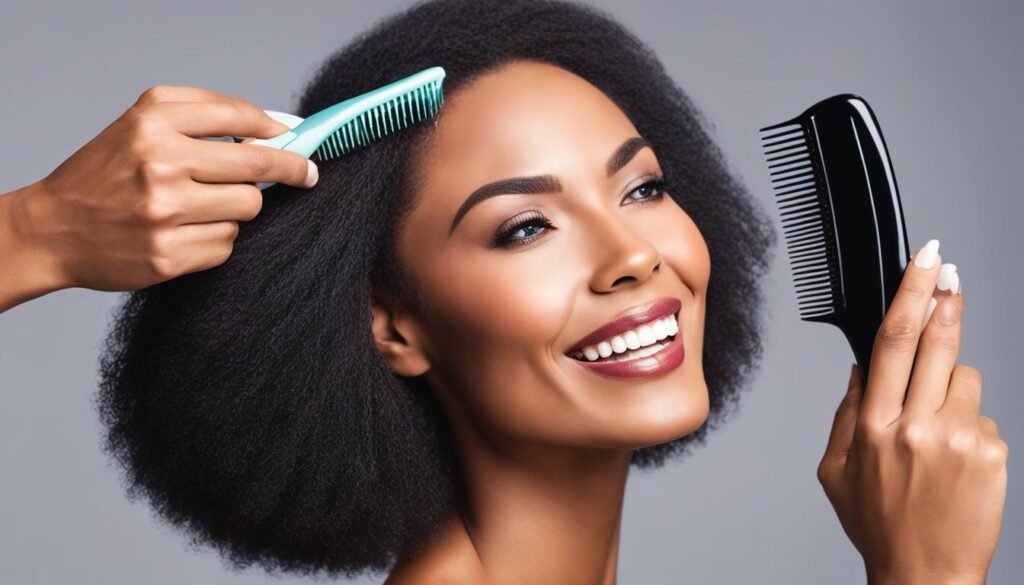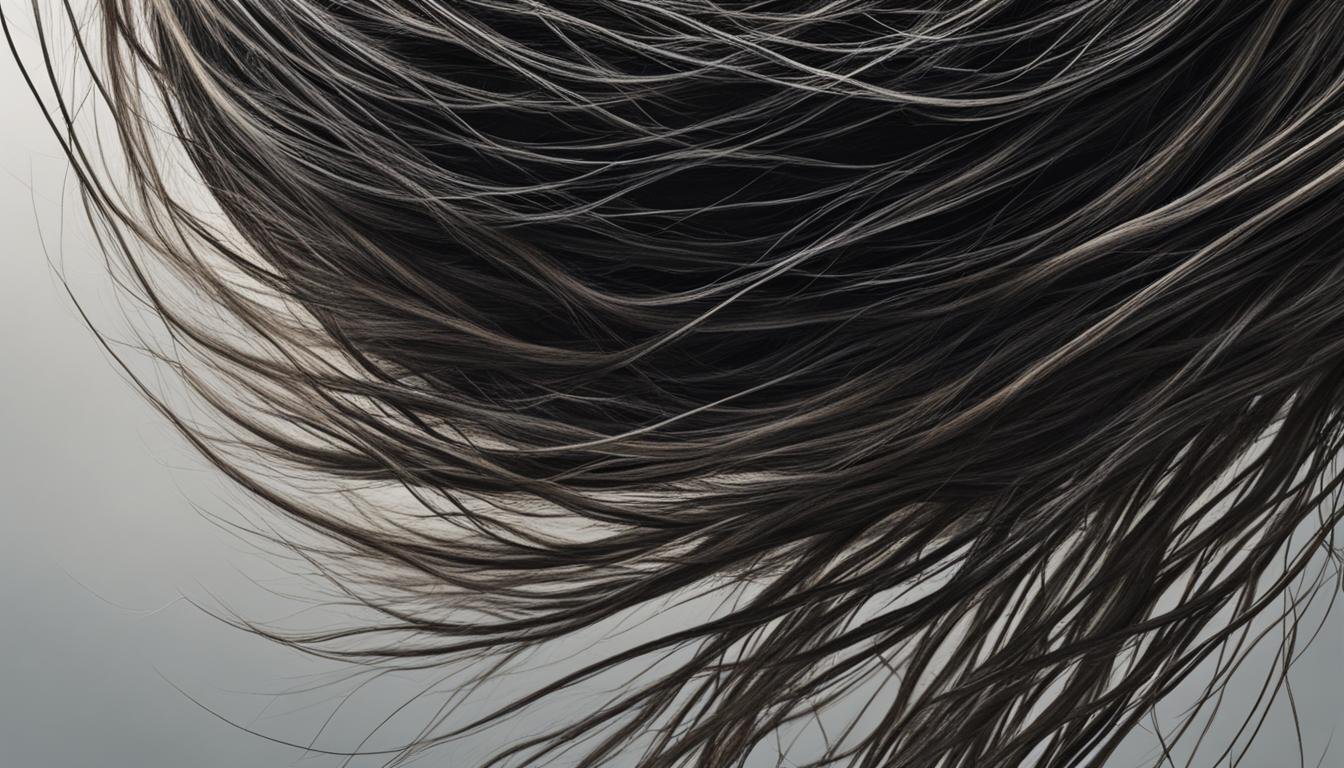If you find yourself constantly dealing with tangled hair and noticing more hair fall than usual, you’re not alone. Understanding the causes behind tangled hair and hair loss can help you implement the right hair care routine and remedies to prevent further damage. In this article, we will delve into the common causes of hair tangling and hair loss, as well as provide valuable tips and remedies to help you prevent hair breakage and promote healthy hair growth.
There are several factors that can contribute to tangled hair. Exposure to wind, rough washing or drying techniques, damaged or curly hair, excessive heat exposure, and chemical treatments are among the main causes. Additionally, deficiencies in iron, zinc, protein, and vitamin D can contribute to hair loss.
If you’re experiencing hair loss, it’s essential to consider genetics, aging, hormone changes, medical conditions, cancer treatments, medications, stress, and nutritional deficiencies as potential causes. It’s normal to lose around 50-100 hairs per day, but hair falling out in clumps or a significant increase in hair loss may indicate an underlying scalp disorder or health condition.
For women, hormonal imbalances, iron or vitamin deficiencies, and damage from styling can contribute to hair loss. Implementing a nutritious diet, avoiding harsh chemicals, and using proper hair care techniques can help prevent further hair loss. Increasing intake of specific vitamins such as A, B7, C, D, and E may promote hair growth and strengthen the hair follicles.
If you’re concerned about hair tangling, dryness is often the main culprit. Dry hair is more prone to matting and tangling, which can result from using chemical-based products, styling with heat, exposure to hard shower water, and poor diet. Switching to naturally-derived hair care products, incorporating vitamins and nutrients, and using silk pillowcases and scrunchies can help reduce knots and tangles.
In the following sections, we will explore in-depth the causes of hair tangling and hair loss after washing, factors that contribute to knotty hair, remedies for detangling hair, and tips for preventing hair tangles and hair loss. By understanding the root causes and implementing the right strategies, you can achieve healthier, more manageable hair.
What Causes Hair Tangles and Knots?
One of the main causes of tangled hair is dryness. Dry hair is more prone to matting and tangling, which can be exacerbated by various factors such as the use of chemical-based products, styling with heat, exposure to hard shower water, and a poor diet.
Chemical-based products, such as certain shampoos, conditioners, and styling products, can strip the hair of its natural oils, leading to dryness and increased tangling. Similarly, excessive heat from hair dryers, curling irons, and straighteners can damage the hair’s cuticle, causing it to become dry and more prone to tangles.
Additionally, the quality of the water used during showering can contribute to tangling. Hard water, which is high in mineral content, can leave a residue on the hair, making it more difficult to retain moisture and leading to dryness and tangles.
Poor dietary choices, such as a lack of sufficient hydration and a deficiency in essential nutrients, can also contribute to dryness and hair tangles. Proper hydration and a balanced diet rich in vitamins, minerals, and healthy fats, such as Omega-3 fatty acids, are essential for maintaining healthy and hydrated hair.
To combat hair tangles and knots, it is recommended to switch to naturally-derived hair care products that are gentle and moisturizing. These products are less likely to strip the hair of its natural oils and can help retain moisture, reducing the chances of tangling.
“Using silk pillowcases and scrunchies can also minimize friction and reduce tangles, as they provide a smoother surface for the hair to rest on.”
Moreover, using a detangling spray before combing or brushing the hair can help ease out knots and minimize breakage. Look for products specifically formulated to detangle hair and spray them onto the hair before gently combing through with a wide-toothed comb or a wet brush.
Overall, addressing the main cause of tangled hair – dryness – through the use of appropriate hair care products, incorporating nutrients and vitamins into the diet, and adopting gentle hair care practices can help prevent and minimize hair tangles and knots.
The main cause of tangled hair is dryness, which can result from:
- Using chemical-based hair products
- Styling hair with heat
- Exposure to hard shower water
- Following a poor diet
Why Hair Gets Tangled After Washing
Hair is more prone to tangling when wet, especially if the hair washing routine is not done correctly. Factors that can contribute to tangled hair after washing include using sulphate-based shampoos, a lack of brushing during washing, and living in a hard water area.
Sulphates can strip the hair of essential moisture, leaving it dry and more susceptible to tangling. Hard water contains minerals that leave a coating on the hair, making it difficult for moisture to penetrate, resulting in tangled strands.
Fortunately, there are ways to prevent hair from getting tangled after washing. First, consider switching to sulphate-free shampoos and conditioners that are gentle on the hair. These products help retain moisture and reduce the likelihood of tangles.
During the hair washing routine, it’s important to brush the hair gently while applying conditioner. This helps to distribute the product evenly and detangle any knots or tangles. Using fingers or a wide-toothed comb can also be effective for untangling large knots without causing further damage or breakage.
By following these tips and taking proper care of your hair, you can minimize the occurrence of tangles after washing and maintain healthy, manageable locks.
Factors That Cause Knotty Hair
Knotty hair can be a frustrating problem that many people face. The presence of knots and tangles can make hair difficult to manage and style. Luckily, understanding the factors that cause these knots can help in effectively preventing them.
One common cause of knotty hair is the incorrect use or removal of hair ties and accessories. Pulling hair tightly or yanking out hair ties can lead to knots and breakage. It’s important to be gentle when handling hair and use proper techniques to avoid tangling.
Poor weather conditions can also contribute to tangled hair. Sunshine, rain, and wind can cause hair to become dry, brittle, and prone to tangling. Protecting hair from harsh weather conditions by using hats or scarves can help prevent knots.
During sleep, movement and friction with the pillow can cause hair to tangle. Using a silk pillowcase can minimize friction and reduce the chances of waking up to knotty hair.
Heat damage from styling tools is another factor that can lead to tangled hair. Excessive heat can weaken the hair strands and make them more prone to tangling. It’s important to use heat protectant products and avoid excessive heat styling.
Diet also plays a role in the health of your hair. A diet lacking in protein and omega-3 fatty acids can contribute to dryness and brittleness, making hair more prone to tangling. Incorporating foods rich in these nutrients, such as fish and nuts, can help promote healthier hair.
Pollution damage is an often overlooked factor that can contribute to tangled hair. Pollutants in the air can build up on the hair shaft, causing it to become dry and tangled. It’s important to protect your hair from pollution by wearing a hat or scarf when in polluted environments.
Sun exposure can also damage the hair cuticle, leading to dryness and tangles. UV rays can strip the hair of its natural moisture, making it more susceptible to tangling. Using protective products with UV filters can help prevent sun damage to the hair.
To prevent knotty hair, it’s important to use proper techniques when handling hair, protect it from poor weather conditions, ensure a gentle sleep environment, avoid excessive heat styling, maintain a healthy diet, and protect it from pollution and sun damage.
Key Points:
- Incorrect use of hair ties and accessories can lead to knotty hair.
- Poor weather conditions, such as sunshine, rain, and wind, can cause dryness and tangling.
- Sleep movements and friction with the pillow can contribute to tangled hair.
- Heat damage from styling tools weakens the hair and makes it more prone to tangling.
- A diet lacking in protein and omega-3 fatty acids can result in dry and brittle hair.
- Pollution and sun exposure can damage the hair cuticle and lead to tangles.
How to Get Knots Out of Hair
When dealing with knots in your hair, it’s important to follow the right steps to prevent further damage and make the detangling process easier. By sectioning your hair, using detangling products, and employing gentle techniques, you can get rid of knots effectively and minimize breakage.
Here is a step-by-step guide on how to get knots out of your hair:
1. Section your hair
Start by parting your hair into sections. This allows you to focus on one area at a time, making it easier to detangle without pulling or causing more knots.
2. Use a detangling product
Apply a detangling product such as a detangling shampoo or conditioner to soften the knots and make them easier to comb through. Look for products specifically designed to detangle hair and nourish it at the same time.
3. Use a wide-toothed comb or wet brush
Gently comb through the knots using a wide-toothed comb or a wet brush. Start from the ends of your hair and work your way up to the roots, using gentle downward strokes. Avoid pulling or tugging, as this can lead to breakage.
4. Rinse thoroughly with water
After detangling, rinse your hair thoroughly with water to remove any residue from the detangling product and ensure your hair is clean.
5. Gently squeeze out excess water
To avoid further tangling, gently squeeze out excess water from your hair. Avoid rough towel drying or rubbing your hair vigorously, as this can cause knots to form.
6. Apply a deep conditioning treatment
Apply a deep conditioning treatment to nourish your hair and restore moisture. This will help prevent future knots and keep your hair healthy.
7. Finish with a leave-in conditioner
Finish off the detangling process by applying a leave-in conditioner. This will provide added moisture and make your hair more manageable, reducing the chances of knots forming.
By following these steps, you can effectively get rid of knots in your hair and maintain healthy, tangle-free locks.

Tips for Preventing Hair Tangles and Hair Loss
To maintain healthy and tangle-free hair, it is important to follow these simple tips:
1. Maintain a Healthy Diet: A nutritious diet plays a crucial role in promoting hair health. Include foods rich in vitamins, minerals, and proteins, such as leafy greens, fruits, lean meats, and nuts. A well-balanced diet nourishes the hair follicles and helps prevent hair loss.
2. Consider Taking Supplements: If your diet is lacking in essential nutrients, consider taking supplements that support hair health. Look for supplements containing vitamins like biotin, vitamin E, and omega-3 fatty acids, as they promote strong and healthy hair growth.
3. Avoid Harsh Chemicals: Harsh chemicals found in some hair care products can strip the hair of its natural oils, leading to dryness and breakage. Opt for gentle, natural, and sulfate-free products to prevent hair tangles and protect your strands.
4. Stop or Switch Medications: Certain medications can cause hair loss as a side effect. If you notice excessive hair shedding or hair loss while taking a particular medication, consult your doctor to explore alternative options or adjustment of dosage.
By incorporating these tips into your hair care routine, you can prevent hair tangles and reduce the risk of hair loss. Remember to consult with a healthcare professional for personalized advice and treatment options that best suit your specific needs.
